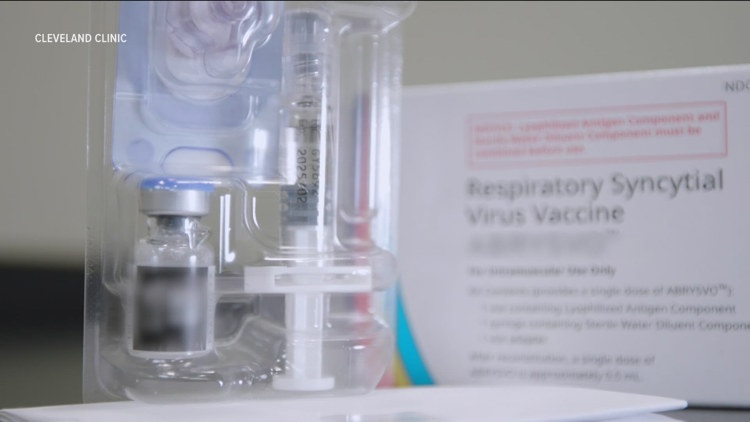Kare11
HealthPartners gets grant to study RSV vaccine during pregnancy


A national, $3.4-million grant is making the study possible.
BLOOMINGTON, Minn. — HealthPartners is ready for the 2024-2025 RSV season; its medical personnel began administering maternal RSV vaccines this month as recommended by the CDC.
But the hospital system says many pregnant patients have questions about the shot and are avoiding it all together.
Dr. Kristi Palmsten is senior research investigator with HealthPartners Institute and co-director of its Pregnancy and Child Health Research Center.
While the FDA in August last year approved the RSV vaccine for those between 32 and 36 weeks pregnant, Palmsten says an internal survey revealed many pregnant patients were hesitant to get the one-dose shot. She says some patients indicated they needed more information directly from their health care provider to make a decision.
“People tend to have questions when there’s a newer product on the market,” Palmsten said. “It just has less safety data available, although the evidence that are available are reassuring in terms of safety and effectiveness.”
The original clinical trial, for example, did not include any lactation-related data or long-term infant and child health effects, she says. Now though, HealthPartners has new funding to gather that information and more.
“The award is from the Eunice Kennedy Shriver National Institute of Child Health and Human Development and it’s for $3.4 million to study the prenatal RSV vaccine in relation to birth outcomes, lactation-related outcomes and child health outcomes up to age three,” Palmsten explained.
Palmsten said she could not comment whether the 2024-2025 vaccine is the same as what the FDA approved last year, but says the new research should help answer other patient questions.
In the 5-year study, researchers will collect data from electronic health records at HealthPartners and a few other healthcare systems nationwide.
“Data that’s routinely collected at infant, well-child visits and postpartum visits,” Palmsten said. “The evidence will help patients make up their mind about whether or not they want to receive it.”
The grant comes as RSV remains the leading cause of infant hospitalizations in the U.S.
So far, researchers say the RSV vaccine creates antibodies that are passed from pregnant person to fetus, protecting it against severe infection. In many cases, the protection can last up to six months after the baby is born.
“Vaccination during pregnancy is shown to have 69% efficacy against severe RSV in the infant up to six months,” according to a HealthPartners press release.
Kare11
New aquatic robot holds promise for water quality


The robot is a unique-looking device with three clear tubes that contain the electronic brains and guts.
WAYZATA, Minn. — Finding and solving water quality problems in the Land of 10,000 Lakes may soon have a new, lower-cost helper — an aquatic robot — that has been designed by and is undergoing tests at the University of Minnesota.
The autonomous underwater vehicle, which is named MeCO for Medium Cost Open Source Robot, costs under $10,000 to build versus more than 10 times that for a prebuilt machine. Open source means the design is out there for all, free of charge, offering multiple possibilities, including finding invasive species, inspecting ships, and locating trash.
“So, all you need to do is buy the parts, look at the manual — assembly manual — build it, and run it,” said Dr. Junaed Sattar, who is leading the University of Minnesota research.
In late August, Sattar and his team set up on the Wayzata Beach and Marina to conduct a field test on the device’s autonomous abilities. The robot is a unique-looking device with three clear tubes that contain the electronic brains and guts. If viewing from one end, the tubes are stacked like firewood with two on the bottom and one on the top, in essence, forming a triangle. Multiple propellers are mounted on the device.
The robot can also even “see.”
While preparing on the beach, Dave Widhalm, student research lead, asks a teammate, “Want me to restart the camera?”
Grant Schwidder, an undergraduate computer science major, who is running a connected laptop, later notes, “OK, cameras are updating.”
Once the robot is ready, Sattar and Widhalm don scuba gear, so they can “play” with the robot under water. They will also be joined by a red target, which looks orange under water, that Widhalm will tow to see if the robot can find and follow.
“This is unique because it’s a diver’s buddy, as in, it does not only do autonomous behaviors; it also understands the humans that it’s working with,” Sattar said.
Think about that. For example, a diver could point, and the robot would respond.
But on this August day, in the autonomous test, the human-robot interaction is limited to Widhalm towing the target to see what the robot sees and does.
Aquatic robot a welcome possibility
Roughly an hour-and-a-half to the west of Lake Minnetonka on a New London lake, Jon Morales, program manager, Middle Fork Crow River Watershed District, who is doing his own water quality work in late August, is keenly interested in the aquatic robot testing.
“You can think of it as like sort of like a bloodhound or a heat-seeking drone,” Morales said.
Here on this stretch of the Middle Fork Crow River, Morales faces a water quality issue that he thinks could use the robot.
Annually, as ice leaves the river, a spring-only smell emerges, resulting from bacteria spending the winter gobbling river-bottom sediment that deposits above the New London dam.
“It smells. It smells pretty bad. So that hydrogen sulfide gas smells a lot like rotten eggs,” Morales said.
In exploring the annual odor, Morales collects data through a special probe and water samples at six locations — five of them monthly and one spot twice a month.
Still, under current methods, finding the odor-producing hot spots, which could ultimately lead to solutions, is tough.
“A better way would be amazing. You know this is a, it’s a time-consuming process. It’s tedious,” Morales said.
Aquatic robot success
Back on Lake Minnetonka on that late August day, it takes mere minutes for the divers to see that the robot successfully chased the target.
Widhalm emerges from the water, proclaiming, “Worked great,” later adding, “Followed me around the entire time.”
“That was awesome; super nice,” Sattar declared.
During such field tests, Sattar has people like Jon Morales in mind.
“This is robots making jobs easier and extending the capabilities of the field experts, so Jon is one of those people,” Sattar said.
In the big picture, Sattar and his research team’s aquatic robot holds tremendous promise for Minnesota’s 10,000 jewels.
“So, the hope would be that one day we can actually use this to clean up our lakes and keep them clean,” Widhalm said.
Kare11
Man charged in 57-year-old woman’s death


Byron Vinicio Varga Bautista is charged with 2nd-degree murder after prosecutors say he beat a 57-year-old woman and left her body outside a church in Minneapolis.
MINNEAPOLIS — A 38-year-old Minneapolis man is charged after a woman was found dead near a Minneapolis church back in July.
Byron Vinicio Varga Bautista is charged with second-degree murder after prosecutors say he beat a 57-year-old woman and left her body outside a church near Oak Park Avenue North and Penn Avenue North. Police were called to the area in the afternoon of July 14 and found a woman with injuries to her face and upper body.
A medical examiner later identified her cause of death to be blunt force trauma. Court documents say the woman suffered hemorrhaging around her brain, neck and clavicle. Her hyoid bone was also fractured. Investigators later identified the woman to be a 57-year-old resident at a Minneapolis skilled nursing facility.
According to the criminal complaint, witnesses say they saw the woman with a man, later identified as Bautista, on the evening of July 13. Officials obtained video from Metro Transit buses that appeared to show Bautista and the woman travelling through the city and eventually leaving the bus near Penn Avenue North and Olive Avenue North.
Court documents say surveillance videos from surrounding homes in the area captured Bautista and the woman walking toward the church where the woman’s body was eventually discovered. Prosecutors say traffic cameras then showed what appeared to be Bautista carrying the woman, and additional videos showed Bautista allegedly going back and forth to the area of the crime, before eventually leaving.
Police were driving around south Minneapolis on Sept. 19 when they spotted a man who fit the description of the suspect. He was arrested and remains in custody. According to court documents, Bautista identified himself in numerous images, but didn’t claim to know the victim and said he didn’t remember what happened on July 13.
Kare11
Minneapolis Vibrant Storefronts program reviewing applications


The initiative will give artists the opportunity to move into empty storefronts in Loring Park, in an effort to boost the neighborhood.
MINNEAPOLIS — To fill vacant properties in the downtown corridor, the city of Minneapolis is currently reviewing applications for the Vibrant Storefronts Initiative, which will provide subsidized rent to artists in the Loring Park area over the course of two years.
Three of the buildings with available space are located on Harmon Place, a city-designated historic district that was once home to a thriving automotive industry.
Katie Cashman, the Ward 7 Council Member and one of the leading advocates for the initiative, said potential tenants could include artists, arts organizations and arts businesses.
“It’s open to a wide range of media, not just visual arts but theater, dance, music, you name it. Certainly, it’s a huge benefit to the artists themselves, being able to work in a brick-and-mortar space,” Cashman said. “Also, for the property owners, they haven’t been able to find retail tenants to fill their space. They’ll greatly benefit, and it allows us to get at this issue of our property tax base falling in the city of Minneapolis.”
The city council has allocated an initial $250,000 this year for the storefront program in Loring Park, but Mayor Frey has proposed more than $1 million in the 2025 budget for an expansion of the program into Uptown.
Cashman said she hopes Minneapolis can ultimately follow the model of Berlin, Germany — the city where she received her master’s degree — by establishing an art hub.
“After the fall of the Berlin Wall in 1989, the city heavily invested in artists and you see the impact of that today, with Berlin being worldwide recognized for being an artistic city. Let’s put Minneapolis on the map in that way as well,” Cashman said. “You felt that spirit while you were there, that creatives were welcome there, creatives can thrive there.”
Rod Morabito, an employee at the longtime company Anderson Crane on Harmon Place, said he’s noticed a lot of artists in the neighborhood lately scoping out the properties involved in the Vibrant Storefronts initiative. The city will notify applicants about funding awards next month, and if selected, those artists would sign two-year leases with up to $50,000 available each year.
“It would be nice to see some of these buildings that have been unused for so long, to get renovated and see more traffic in the area,” Morabito said. “I think we can really help pick up our city.”
At a press conference on Tuesday, Mayor Frey made a brief mention of the arts program as a part of the city’s wider downtown revitalization efforts.
Frey also signed a separate ordinance — co-sponsored by Cashman and fellow council member Michael Rainville — to streamline the process for developers to convert empty office spaces into housing.
One such project, at the Northstar Center, is already underway to create more than 200 lofts in a building once used for Wells Fargo and Hennepin County dispatch.
“It means activating underutilized space so it’s not just a bunch of a desks in a vacant office,” Frey said. “It means adding art, it means adding residents, and a big part of adding residents, was this ordinance that just passed.”

